Late Shelf Life Saturation of Golden Delicious Apple Parameters: TSS, Weight, and Colorimetry
Abstract
1. Introduction
2. Materials and Methods
2.1. Measurement of Weight Loss
2.2. Measurement of Color
2.3. Measurement of Total Soluble Solids (TSS)
2.4. Statistical Analysis
3. Results
3.1. Weight Loss (%)
3.2. Color Analysis
3.3. Total Soluble Solids
4. Discussion
5. Conclusions
Author Contributions
Funding
Institutional Review Board Statement
Informed Consent Statement
Data Availability Statement
Acknowledgments

Conflicts of Interest
References
- FAOSTAT. Available online: https://www.fao.org/faostat/en/#home (accessed on 28 February 2022).
- Ziv, C.; Fallik, E. Postharvest Storage Techniques and Quality Evaluation of Fruits and Vegetables for Reducing Food Loss. Agronomy 2021, 11, 1133. [Google Scholar] [CrossRef]
- Kassebi, S.; Korzenszky, P. The Effect of Post-Harvest Storage on the Weight of Golden Delicious Apples. Sci. Technol. Innov. 2021, 13, 7–11. [Google Scholar] [CrossRef]
- Farkas, C.; Fenyvesi, L.; Petróczki, K. Multiple Linear Regression Model of Golden Apple’s Failure Characteristics under Repeated Compressive Load. Potravin. Slovak J. Food Sci. 2019, 13, 793–799. [Google Scholar] [CrossRef] [PubMed]
- Cömert, E.D.; Mogol, B.A.; Gökmen, V. Relationship between Color and Antioxidant Capacity of Fruits and Vegetables. Curr. Res. Food Sci. 2020, 2, 1–10. [Google Scholar] [CrossRef] [PubMed]
- Majdan, M.; Bobrowska-Korczak, B. Active Compounds in Fruits and Inflammation in the Body. Nutrients 2022, 14, 2496. [Google Scholar] [CrossRef]
- Butkeviciute, A.; Abukauskas, V.; Janulis, V.; Kviklys, D. Phenolic Content and Antioxidant Activity in Apples of the ‘Galaval’ Cultivar Grown on 17 Different Rootstocks. Antioxidants 2022, 11, 266. [Google Scholar] [CrossRef]
- Peace, C.P.; Bianco, L.; Troggio, M.; van de Weg, E.; Howard, N.P.; Cornille, A.; Durel, C.-E.; Myles, S.; Migicovsky, Z.; Schaffer, R.J.; et al. Apple Whole Genome Sequences: Recent Advances and New Prospects. Hortic. Res. 2019, 6, 59. [Google Scholar] [CrossRef]
- Chen, Z.; Yu, L.; Liu, W.; Zhang, J.; Wang, N.; Chen, X. Research Progress of Fruit Color Development in Apple (Malus Domestica Borkh.). Plant Physiol. Biochem. 2021, 162, 267–279. [Google Scholar] [CrossRef]
- Musacchi, S.; Serra, S. Apple Fruit Quality: Overview on Pre-Harvest Factors. Sci. Hortic. 2018, 234, 409–430. [Google Scholar] [CrossRef]
- Milošević, T.; Milošević, N.; Mladenović, J. Role of Apple Clonal Rootstocks on Yield, Fruit Size, Nutritional Value and Antioxidant Activity of ‘Red Chief® Camspur’ Cultivar. Sci. Hortic. 2018, 236, 214–221. [Google Scholar] [CrossRef]
- Milošević, T.; Milošević, N.; Mladenović, J. The Influence of Organic, Organo-Mineral and Mineral Fertilizers on Tree Growth, Yielding, Fruit Quality and Leaf Nutrient Composition of Apple Cv. ‘Golden Delicious Reinders.’ Sci. Hortic. 2022, 297, 110978. [Google Scholar] [CrossRef]
- Caballero, D.; Antequera, T.; Caro, A.; del Mar Ávila, M.; G Rodríguez, P.; Perez-Palacios, T. Non-Destructive Analysis of Sensory Traits of Dry-Cured Loins by MRI–Computer Vision Techniques and Data Mining. J. Sci. Food Agric. 2017, 97, 2942–2952. [Google Scholar] [CrossRef] [PubMed]
- Caballero, D.; Pérez-Palacios, T.; Caro, A.; Amigo, J.M.; Dahl, A.B.; ErsbØll, B.K.; Antequera, T. Prediction of Pork Quality Parameters by Applying Fractals and Data Mining on MRI. Food Res. Int. 2017, 99, 739–747. [Google Scholar] [CrossRef] [PubMed]
- Ma, J.; Sun, D.-W.; Qu, J.-H.; Liu, D.; Pu, H.; Gao, W.-H.; Zeng, X.-A. Applications of Computer Vision for Assessing Quality of Agri-Food Products: A Review of Recent Research Advances. Crit. Rev. Food Sci. Nutr. 2015, 56, 113–127. [Google Scholar] [CrossRef]
- Ekramirad, N.; Adedeji, A.; Alimardani, R. A Review of Non-Destructive Methods for Detection of Insect Infestation in Fruits and Vegetables. Innov. Food Res. 2016, 2, 6–12. [Google Scholar]
- Yang, S.; Meng, Z.; Li, Y.; Chen, R.; Yang, Y.; Zhao, Z. Evaluation of Physiological Characteristics, Soluble Sugars, Organic Acids and Volatile Compounds in ’Orin’ Apples (Malus Domestica) at Different Ripening Stages. Molecules 2021, 26, 807. [Google Scholar] [CrossRef]
- Kamiloǧlu, Ö. Influence of Some Cultural Practices on Yield, Fruit Quality and Individual Anthocyanins of Table Grape CV. “Horoz Karasi.” J. Anim. Plant Sci. 2011, 21, 240–245. [Google Scholar]
- Yang, Y.; Zhou, B.; Zhang, J.; Wang, C.; Liu, C.; Liu, Y.; Zhu, X.; Ren, X. Relationships between Cuticular Waxes and Skin Greasiness of Apples during Storage. Postharvest Biol. Technol. 2017, 131, 55–67. [Google Scholar] [CrossRef]
- Khodaei, D.; Hamidi-Esfahani, Z.; Rahmati, E. Effect of Edible Coatings on the Shelf-Life of Fresh Strawberries: A Comparative Study Using TOPSIS-Shannon Entropy Method. NFS J. 2021, 23, 17–23. [Google Scholar] [CrossRef]
- Sinha, S.R.; Singha, A.; Faruquee, M.; Jiku, A.S.; Rahaman, A.; Alam, A.; Kader, M.A. Post-Harvest Assessment of Fruit Quality and Shelf Life of Two Elite Tomato Varieties Cultivated in Bangladesh. Bull. Natl. Res. Cent. 2019, 43, 185. [Google Scholar] [CrossRef]
- Mardziah, O.; Mat Jafri, M.Z.; Abdul Aziz, A.; Omar, A. Non-Destructive Quality Evaluation of Fruit by Color Based on RGB LEDs System. In Proceedings of the 2014 2nd International Conference on Electronic Design, ICED 2014, Penang, Malaysia, 19–21 August 2015; pp. 230–233. [Google Scholar]
- Mesa, A.R.; Chiang, J.Y. Multi-Input Deep Learning Model with RGB and Hyperspectral Imaging for Banana Grading. Agriculture 2021, 11, 687. [Google Scholar] [CrossRef]
- Garrido-Novell, C.; Pérez-Marin, D.; Amigo, J.M.; Fernández-Novales, J.; Guerrero, J.E.; Garrido-Varo, A. Grading and Color Evolution of Apples Using RGB and Hyperspectral Imaging Vision Cameras. J. Food Eng. 2012, 113, 281–288. [Google Scholar] [CrossRef]
- Cen, H.; Lu, R.; Mendoza, F.; Beaudry, R.M. Relationship of the Optical Absorption and Scattering Properties with Mechanical and Structural Properties of Apple Tissue. Postharvest Biol. Technol. 2013, 85, 30–38. [Google Scholar] [CrossRef]
- Cárdenas-Pérez, S.; Chanona-Pérez, J.; Méndez-Méndez, J.V.; Calderón-Domínguez, G.; López-Santiago, R.; Perea-Flores, M.J.; Arzate-Vázquez, I. Evaluation of the Ripening Stages of Apple (Golden Delicious) by Means of Computer Vision System. Biosyst. Eng. 2017, 159, 46–58. [Google Scholar] [CrossRef]
- Khorshidi, J. Storage Temperature Effects on the Postharvest Quality of Apple (Malus Domestica Borkh. Cv. Red Delicious). N. Y. Sci. J. 2019, 3, 67–70. [Google Scholar]
- de AlmeidaTeixeira, G.H.; Meakem, V.; Morais, C. de L.M. de; Lima, K.M.G. de; Whitehead, S.R. Conventional and Alternative Pre-Harvest Treatments Affect the Quality of ‘Golden Delicious’ and ‘York’ Apple Fruit. Environ. Exp. Bot. 2020, 173, 104005. [Google Scholar] [CrossRef]
- Rutkowski, K.; Michalczuk, B.; Konopacki, P. Nondestructive Determination of “Golden Delicious” Apple Quality and Harvest Maturity. J. Fruit Ornam. Plant Res. 2008, 16, 39–52. [Google Scholar]
- Jha, S.N.; Rai, D.R.; Shrama, R. Physico-Chemical Quality Parameters and Overall Quality Index of Apple during Storage. J. Food Sci. Technol. 2012, 49, 594–600. [Google Scholar] [CrossRef]
- Bavisetty, S.C.B.; Venkatachalam, K. Physicochemical Qualities and Antioxidant Properties of Juice Extracted from Ripe and Overripe Wax Apple as Affected by Pasteurization and Sonication. J. Food Process. Preserv. 2021, 45, e15524. [Google Scholar] [CrossRef]
- Dobrzański, B.; Rybczyński, R. Colour Change of Apple as a Result of Storage, Shelf-Life, and Bruising. Int. Agrophysics 2002, 16, 261–268. [Google Scholar]
- Calrson, J.K.; Goldman, K.J. (Eds.) Special Issue: Age and Growth of Chondrichthyan Fishes: New Methods, Techniques and Analysis, 1st ed.; Springer: Dordrecht, The Nederlands, 2006. [Google Scholar]
- Li, M.; Feng, F.; Cheng, L. Expression Patterns of Genes Involved in Sugar Metabolism and Accumulation during Apple Fruit Development. PLoS ONE 2012, 7, e33055. [Google Scholar] [CrossRef] [PubMed]
- Alibas, I.; Zia, M.P.; Yilmaz, A.; Asik, B.B. Drying Kinetics and Quality Characteristics of Green Apple Peel (Mallus Communis L. Var. “Granny Smith”) Used in Herbal Tea Production. J. Food Process. Preserv. 2020, 44, e14332. [Google Scholar] [CrossRef]
- Verde, A.; Míguez, J.M.; Gallardo, M. Melatonin Stimulates Postharvest Ripening of Apples by Up-Regulating Gene Expression of Ethylene Synthesis Enzymes. Postharvest Biol. Technol. 2023, 195, 112133. [Google Scholar] [CrossRef]
- Chen, Y.; Wang, T.; Zhou, M.; Hou, H.; Xue, Y.; Wang, H. Rice Husk and Sewage Sludge Co-Combustion Ash: Leaching Behavior Analysis and Cementitious Property. Constr. Build. Mater. 2018, 163, 63–72. [Google Scholar] [CrossRef]
- Sadat Razavi, M.; Golmohammadi, A.; Nematollahzadeh, A.; Ghanbari, A.; Davari, M.; Rovera, C.; Carullo, D.; Farris, S. Impact of Bacterial Cellulose Nanocrystals-Gelatin/Cinnamon Essential Oil Emulsion Coatings on the Quality Attributes of ‘Red Delicious’ Apples. Coatings 2022, 12, 741. [Google Scholar] [CrossRef]
- Itle, R.A.; Kabelka, E.A. Correlation Between L*a*b* Color Space Values and Carotenoid Content in Pumpkins and Squash (Cucurbita Spp.). HortScience 2009, 44, 633–637. [Google Scholar] [CrossRef]
- Fruit Color—Promoting Red Color Development in Apple. Available online: https://extension.psu.edu/fruit-color-promoting-red-color-development-in-apple (accessed on 13 December 2022).
- Kingston, C.M. Maturity Indices for Apple and Pear. In Hortical Reviews; Janick, J., Ed.; John Wiley & Sons, Ltd.: Hoboken, NJ, USA, 2010; Volume 13, pp. 407–432. [Google Scholar]
- Łysiak, G.; Kurlus, R.; Zydlik, Z.; Walkowiak-Tomczak, D. Apple Skin Colour Changes during Harvest as an Indicator of Maturity. Acta Sci. Pol. Hortorum Cultus 2014, 13, 71–83. [Google Scholar]
- Arendse, E.; Fawole, O.A.; Opara, U.L. Influence of Storage Temperature and Duration on Postharvest Physico-Chemical and Mechanical Properties of Pomegranate Fruit and Arils. CyTA J. Food 2014, 12, 389–398. [Google Scholar] [CrossRef]
- Ahmad, F.; Zaidi, S.; Arshad, M. Postharvest Quality Assessment of Apple during Storage at Ambient Temperature. Heliyon 2021, 7, e07714. [Google Scholar] [CrossRef]
- Ali, M.A.; Raza, H.; Khan, M.A.; Hussain, M. Effect of Different Periods of Ambient Storage on Chemical Composition of Apple Fruit. Int. J. Agric. Biol. 2004, 6, 568–571. [Google Scholar]
- Crouch, I. 1-Methylcyclopropene (Smartfresh Tm) as an Alternative to Modified Atmosphere and Controlled Atmosphere Storage of Apples and Pears. In Proceedings of the 8th International Controlled Atmosphere Research Conference, Rotterdam, The Netherlands, 8–13 July 2001; pp. 433–436. [Google Scholar]
- Vieira, F.G.K.; Borges, G.D.S.C.; Copetti, C.; Amboni, R.D.D.M.C.; Denardi, F.; Fett, R. Physico-Chemical and Antioxidant Properties of Six Apple Cultivars (Malus Domestica Borkh) Grown in Southern Brazil. Sci. Hortic. 2009, 122, 421–425. [Google Scholar] [CrossRef]
- Mizrach, A.; Lu, R.; Rubino, M. Gloss Evaluation of Curved-Surface Fruits and Vegetables. Food Bioprocess. Technol. 2009, 2, 300–307. [Google Scholar] [CrossRef]
- Saletnik, B.; Zaguła, G.; Saletnik, A.; Bajcar, M.; Słysz, E.; Puchalski, C. Method for Prolonging the Shelf Life of Apples after Storage. Appl. Sci. 2022, 12, 3975. [Google Scholar] [CrossRef]
- Ghazanfar, M.; Khan, M.; Khan, C.; Bhatti, R. Post Harvest Losses in Apple and Banana During Transport and Storage. Pak. J. Agric. Sci. 2007, 44, 534–539. [Google Scholar]
- Tano, K.; Oulé, M.K.; Doyon, G.; Lencki, R.W.; Arul, J. Comparative Evaluation of the Effect of Storage Temperature Fluctuation on Modified Atmosphere Packages of Selected Fruit and Vegetables. Postharvest Biol. Technol. 2007, 46, 212–221. [Google Scholar] [CrossRef]
- Gwanpua, S.G.; Mellidou, I.; Boeckx, J.; Kyomugasho, C.; Bessemans, N.; Verlinden, B.E.; Hertog, M.L.A.T.M.; Hendrickx, M.; Nicolai, B.M.; Geeraerd, A.H. Expression Analysis of Candidate Cell Wall-Related Genes Associated with Changes in Pectin Biochemistry during Postharvest Apple Softening. Postharvest Biol. Technol. 2016, 112, 176–185. [Google Scholar] [CrossRef]
- González-Aguilar, G.A.; Ayala-Zavala, J.F.; Olivas, G.I.; de la Rosa, L.A.; Álvarez-Parrilla, E. Preserving quality of fresh-cut products using safe technologies. J. Verbr. Lebensm. 2010, 5, 65–72. [Google Scholar] [CrossRef]


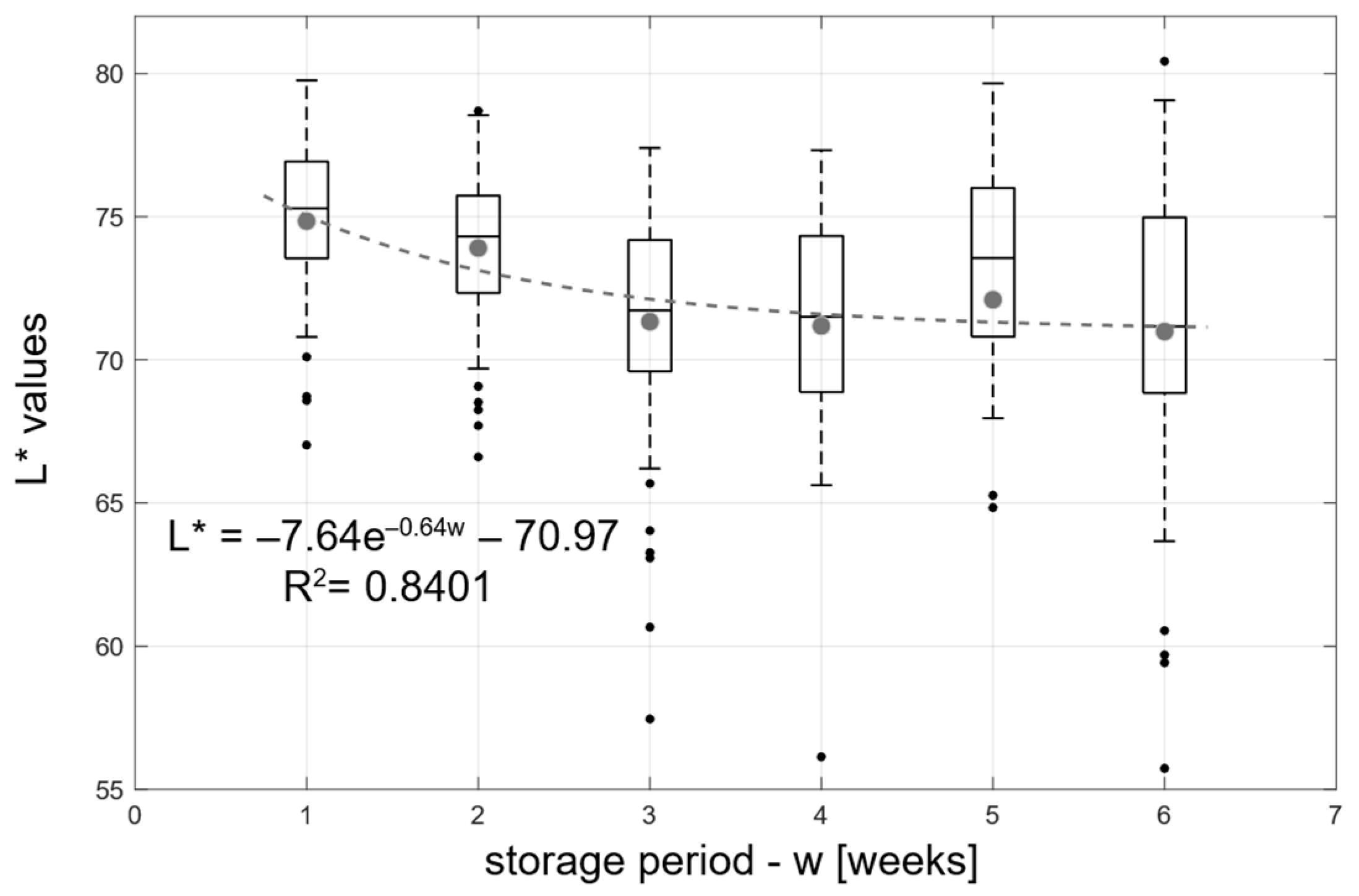
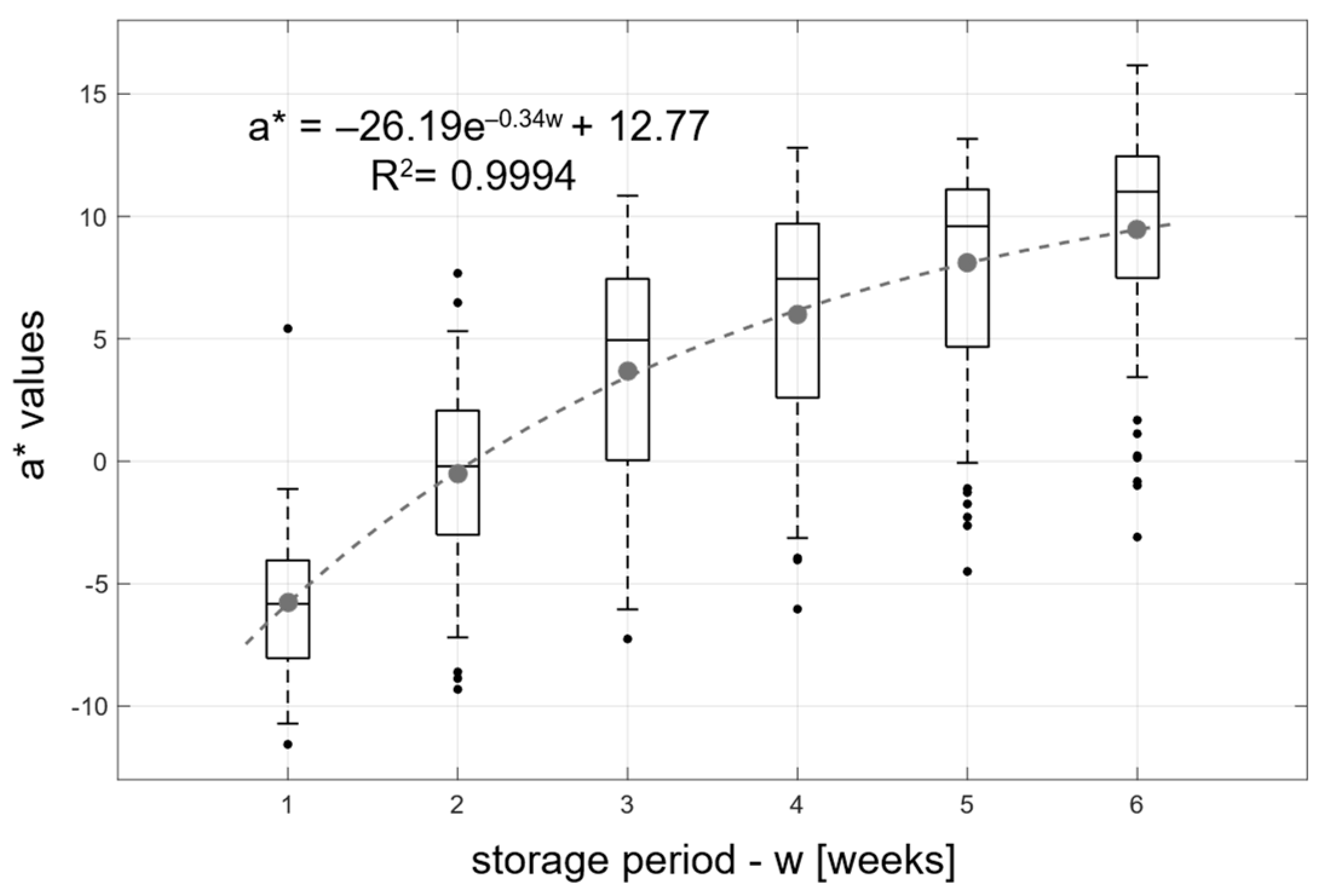

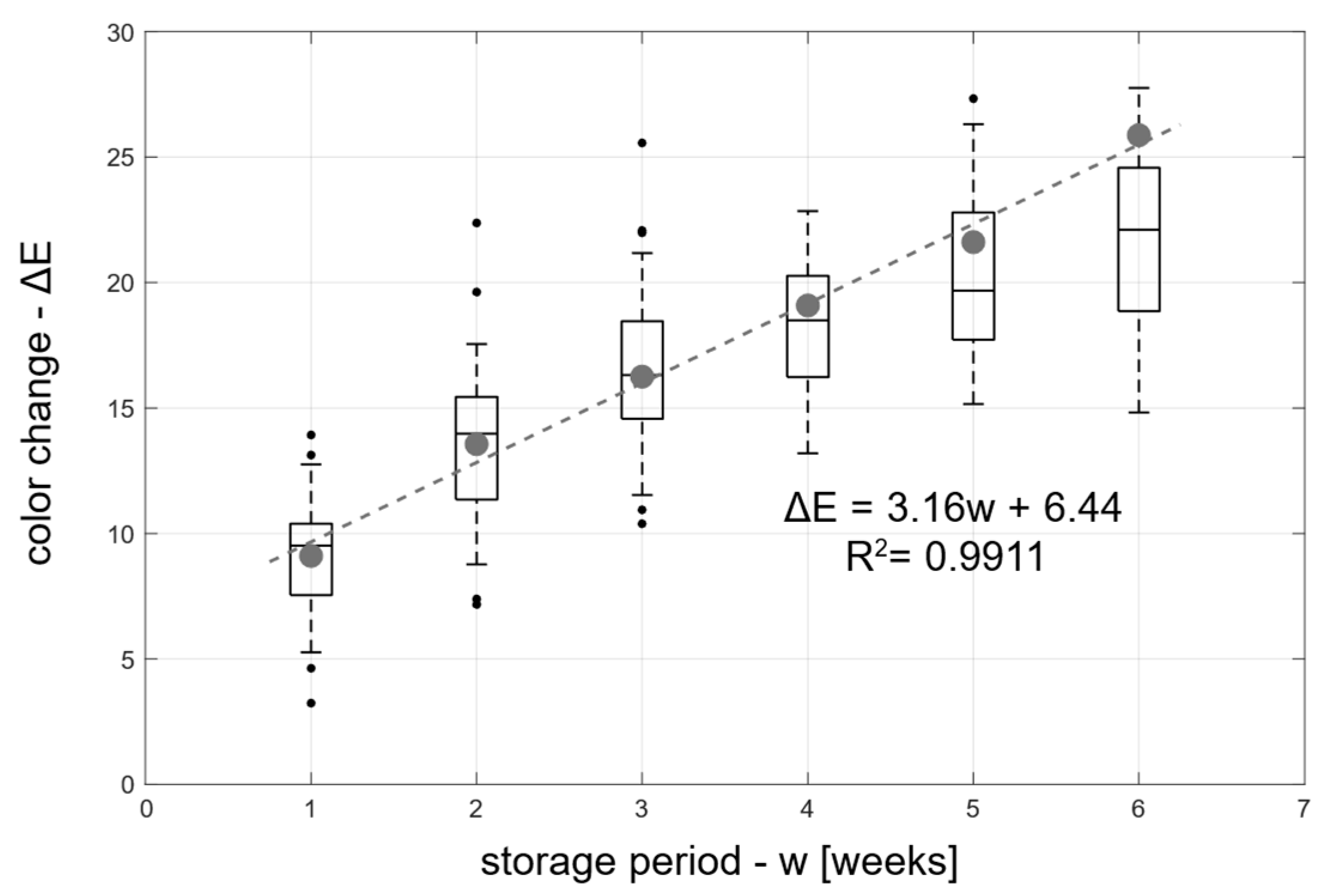
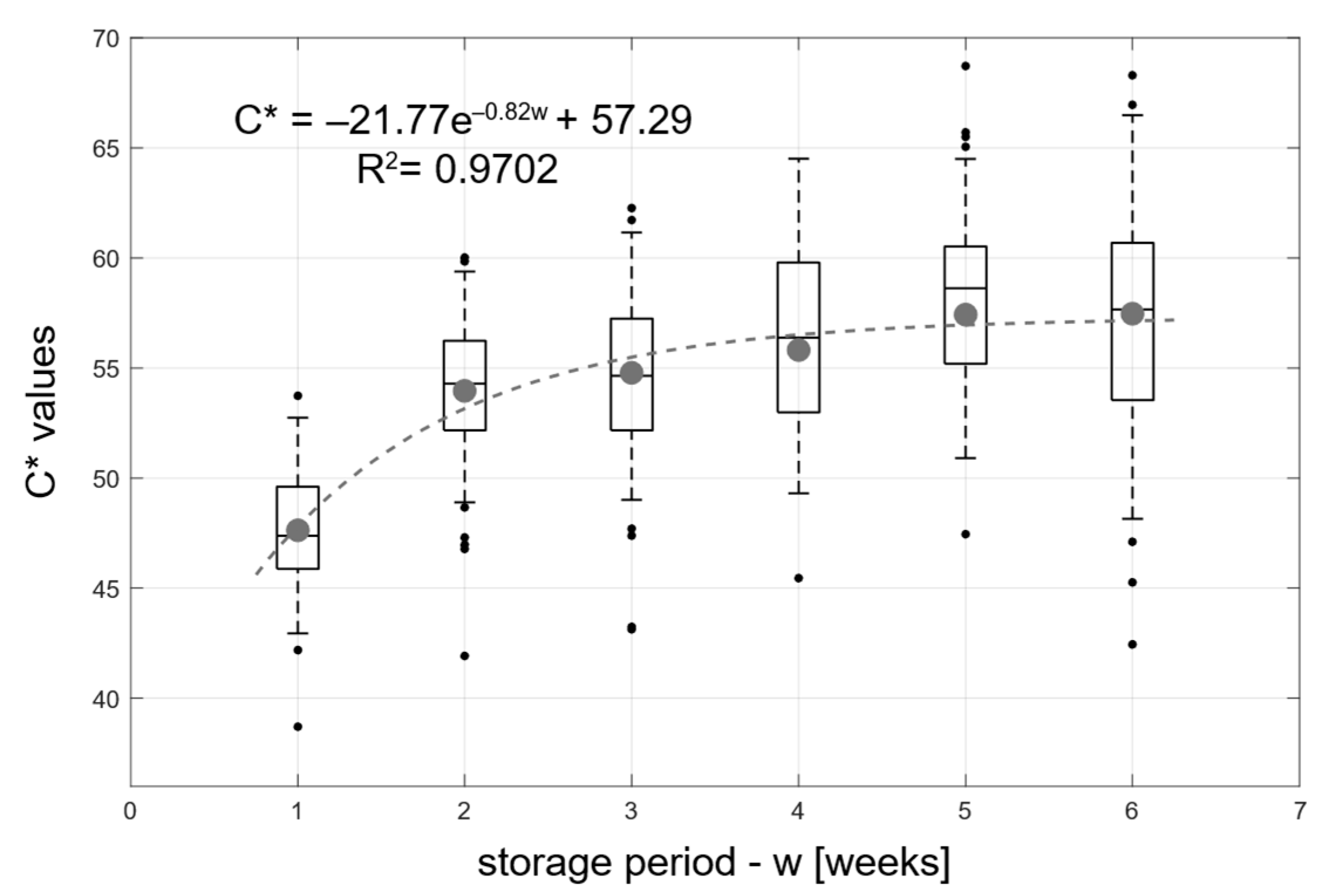
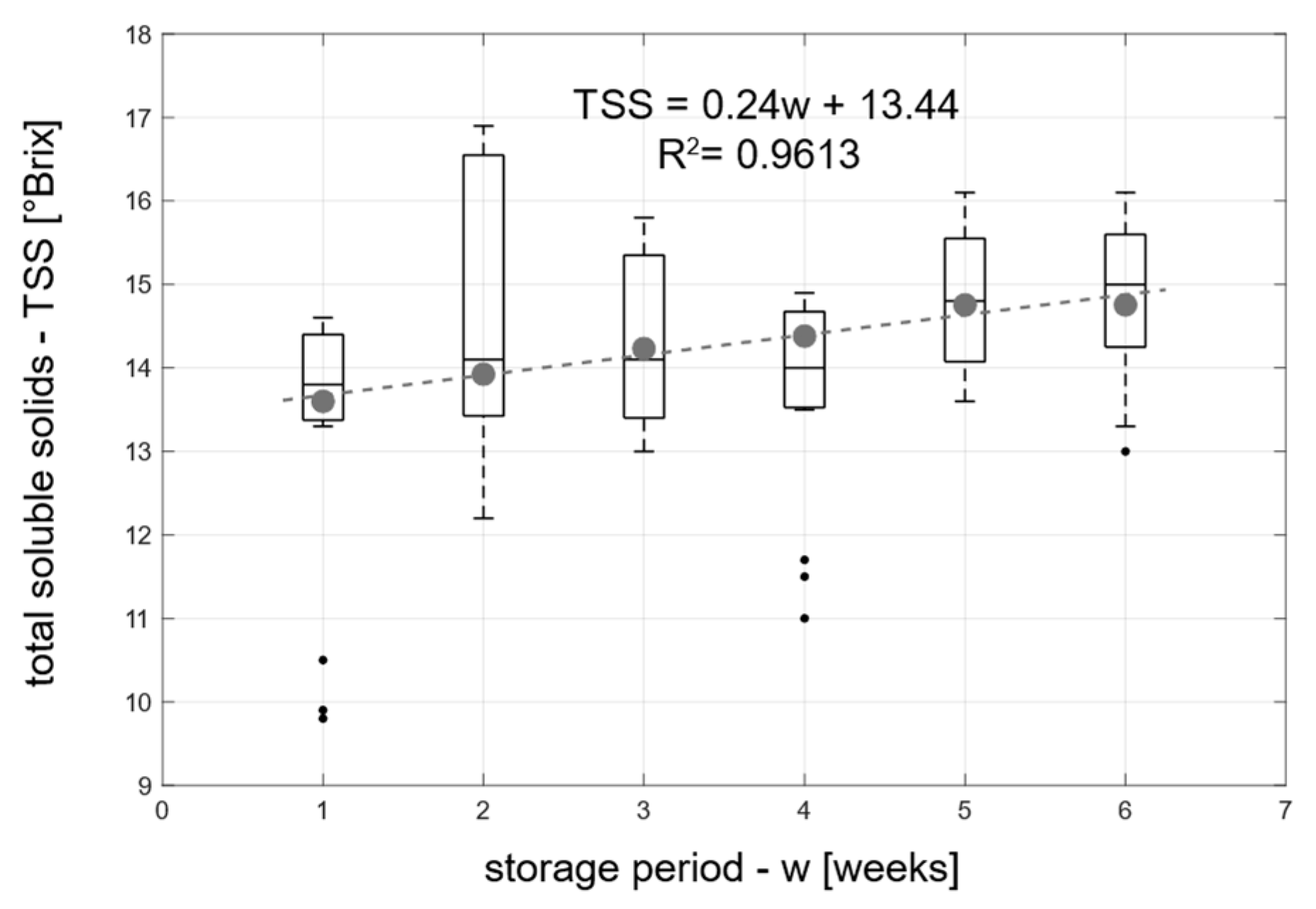
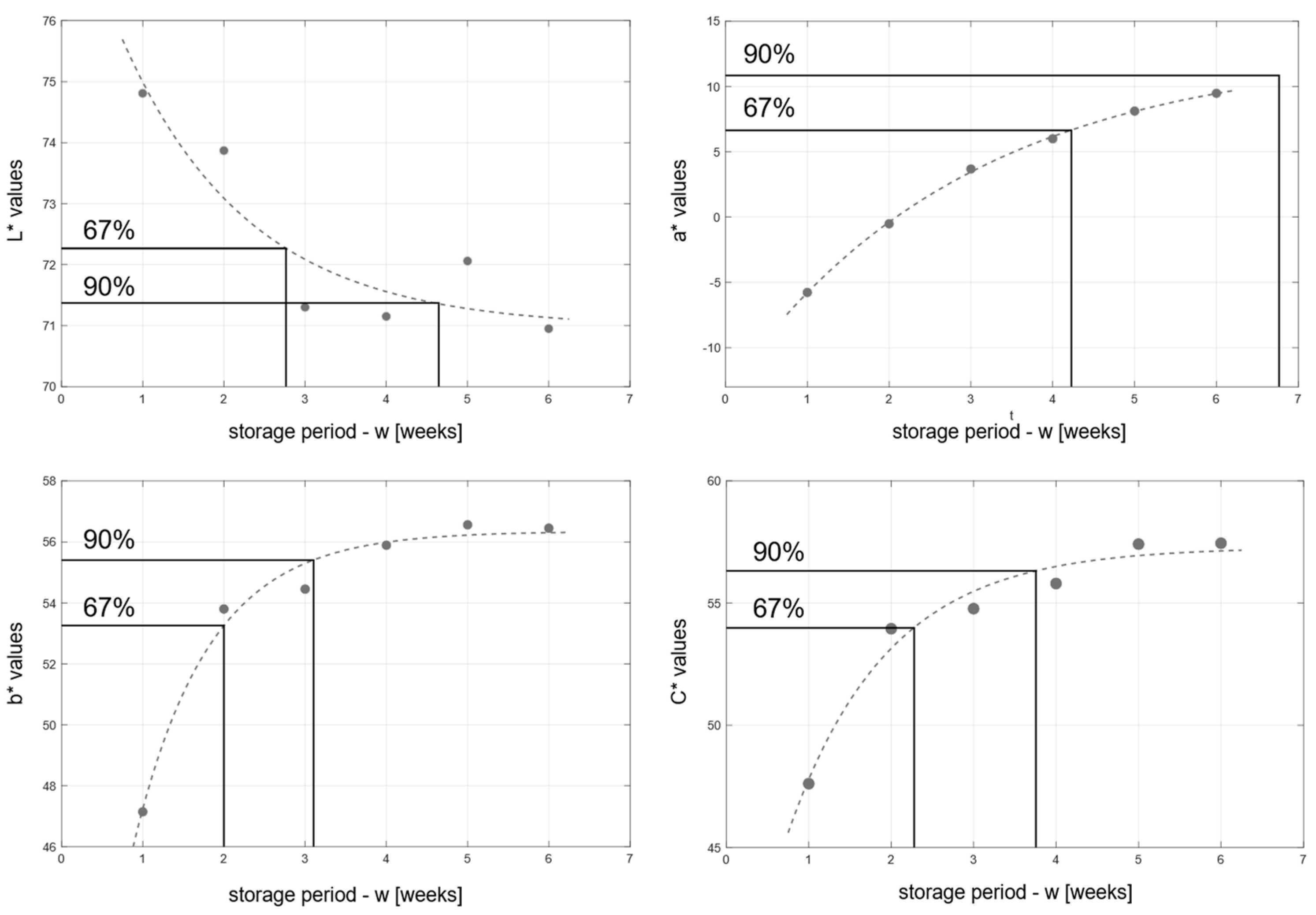
| Week | 2 | 3 | 4 | 5 | 6 |
|---|---|---|---|---|---|
| 1 | p < 0.001 | p < 0.001 | p < 0.001 | p < 0.001 | p < 0.001 |
| 2 | p < 0.001 | p < 0.001 | p < 0.001 | p < 0.001 | |
| 3 | p < 0.001 | p < 0.001 | p < 0.001 | ||
| 4 | p = 0.018 | p < 0.001 | |||
| 5 | p = 0.025 |
| Color Change | |||
| Regression Equations | Coefficient of Determination (R2) | A-Limit Parameter | Consumption Limit (90% Saturation Level) |
| L* = −7.64 e−0.64w − 70.97 | 0.840 | 70.97 (decay) | 71.35 |
| a* = −26.19 e−0.34w + 12.77 | 0.999 | 12.77 (association) | 10.92 |
| b* = −26.85 e−1.08w + 56.34 | 0.981 | 56.34 (association) | 55.42 |
| C* = −21.77 e−0.82w + 57.29 | 0.970 | 57.29 (association) | 56.32 |
| ΔE = 3.16 w + 6.44 | 0.991 | - | - |
| Weight Loss | |||
| Regression Equations | Coefficient of Determination (R2) | A-Limit Parameter | Consumption Limit (90% Saturation Level) |
| Δm = 4.44 w | 0.985 | - | - |
| Total Soluble Solids (TSS) | |||
| Regression Equations | Coefficient of Determination (R2) | A-Limit Parameter | Consumption Limit (90% Saturation Level) |
| TSS = 0.24 w + 13.44 | 0.961 | - | - |
| Storage Time (Weeks) | Parameters beyond Consumption Limit [%] | ||||
|---|---|---|---|---|---|
| L* | a* | b* | C* | TSS | |
| 1 | 15.3 | 0.0 | 0.0 | 0.0 | 5.6 |
| 2 | 11.1 | 0.0 | 31.9 | 25.0 | 16.7 |
| 3 | 44.4 | 0.0 | 40.3 | 36.1 | 30.6 |
| 4 | 50.0 | 11.1 | 55.6 | 51.4 | 25.0 |
| 5 | 36.1 | 34.7 | 66.7 | 67.1 | 27.8 |
| 6 | 58.3 | 55.6 | 63.9 | 60.0 | 63.9 |
Disclaimer/Publisher’s Note: The statements, opinions and data contained in all publications are solely those of the individual author(s) and contributor(s) and not of MDPI and/or the editor(s). MDPI and/or the editor(s) disclaim responsibility for any injury to people or property resulting from any ideas, methods, instructions or products referred to in the content. |
© 2022 by the authors. Licensee MDPI, Basel, Switzerland. This article is an open access article distributed under the terms and conditions of the Creative Commons Attribution (CC BY) license (https://creativecommons.org/licenses/by/4.0/).
Share and Cite
Kassebi, S.; Farkas, C.; Székely, L.; Géczy, A.; Korzenszky, P. Late Shelf Life Saturation of Golden Delicious Apple Parameters: TSS, Weight, and Colorimetry. Appl. Sci. 2023, 13, 159. https://doi.org/10.3390/app13010159
Kassebi S, Farkas C, Székely L, Géczy A, Korzenszky P. Late Shelf Life Saturation of Golden Delicious Apple Parameters: TSS, Weight, and Colorimetry. Applied Sciences. 2023; 13(1):159. https://doi.org/10.3390/app13010159
Chicago/Turabian StyleKassebi, Salma, Csaba Farkas, László Székely, Attila Géczy, and Péter Korzenszky. 2023. "Late Shelf Life Saturation of Golden Delicious Apple Parameters: TSS, Weight, and Colorimetry" Applied Sciences 13, no. 1: 159. https://doi.org/10.3390/app13010159
APA StyleKassebi, S., Farkas, C., Székely, L., Géczy, A., & Korzenszky, P. (2023). Late Shelf Life Saturation of Golden Delicious Apple Parameters: TSS, Weight, and Colorimetry. Applied Sciences, 13(1), 159. https://doi.org/10.3390/app13010159





